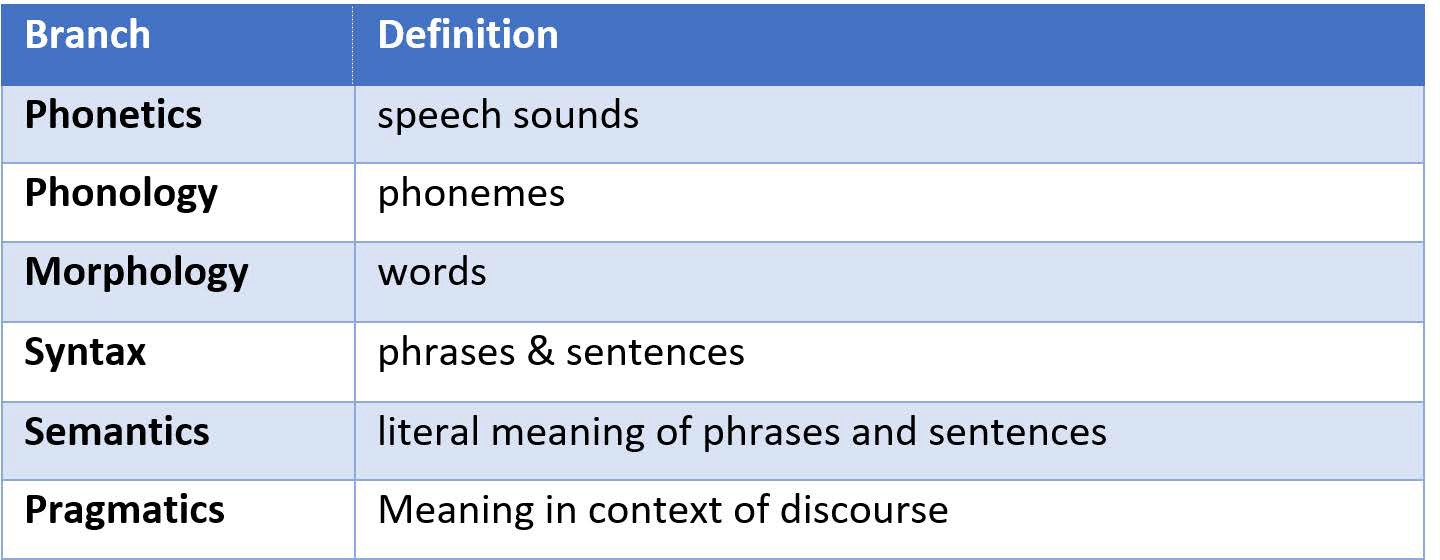95 Introduction to Linguistics
Language is such a special topic that there is an entire field, linguistics, devoted to its study. Linguistics views language in an objective way, using the scientific method and rigorous research to form theories about how humans acquire, use, and sometimes abuse language. There are a few major branches of linguistics, which it is useful to understand in order to learn about language from a psychological perspective.
Video introduces the concept of language, linguistics, and the major branches of linguistics.
Major Branches of Linguistics
This diagram outlines the various subfields of linguistics, the study of language. These include phonetics, phonology, morphology, syntax, semantics, and pragmatics.

Phonetics and Phonology
A phoneme is the smallest unit of sound that makes a meaningful difference in a language. The word “bit” has three phonemes, /b/, /i/, and /t/ (in transcription, phonemes are placed between slashes), and the word “pit” also has three: /p/, /i/, and /t/. In spoken languages, phonemes are produced by the positions and movements of the vocal tract, including our lips, teeth, tongue, vocal cords, and throat, whereas in sign languages phonemes are defined by the shapes and movement of the hands. English contains about 45 phonemes.
Whereas phonemes are the smallest units of sound in language, phonetics is the study of individual speech sounds; phonology is the study of phonemes, which are the speech sounds of an individual language. These two heavily overlapping subfields cover all the sounds that humans can make, as well as which sounds make up different languages.
Morpheme and Morphology
A morpheme is a string of one or more phonemes that makes up the smallest units of meaning in a language. Some morphemes, such as one-letter words like “I” and “a,” are also phonemes, but most morphemes are made up of combinations of phonemes. Some morphemes are prefixes and suffixes used to modify other words. For example, the syllable “re-” as in “rewrite” or “repay” means “to do again,” and the suffix “-est” as in “happiest” or “coolest” means “to the maximum.”
Morphology is the study of words and other meaningful units of language like suffixes and prefixes. A morphologist would be interested in the relationship between words like “dog” and “dogs” or “walk” and “walking,” and how people figure out the differences between those words.
Syntax
Syntax is the set of rules of a language by which we construct sentences. Each language has a different syntax. The syntax of the English language requires that each sentence have a noun and a verb, each of which may be modified by adjectives and adverbs. Some syntaxes make use of the order in which words appear, while others do not.
Syntax is the study of sentences and phrases, or how people put words into the right order so that they can communicate meaningfully. All languages have underlying rules of syntax, which, along with morphological rules, make up every language’s grammar. An example of syntax coming into play in language is “Eugene walked the dog” versus “The dog walked Eugene.” The order of words is not arbitrary—in order for the sentence to convey the intended meaning, the words must be in a certain order.[1]
Semantics and Pragmatics
Semantics, generally, is about the meaning of sentences. Someone who studies semantics is interested in words and what real-world object or concept those words denote, or point to.
Pragmatics is an even broader field that studies how the context of a sentence contributes to meaning. For example, someone shouting “Fire!” has a very different meaning if they are in charge of a seven-gun salute than it does if they are sitting in a crowded movie theater. Every language is different. In English, an adjective comes before a noun (“red house”), whereas in Spanish, the adjective comes after (“casa [house] roja [red].”) In German, you can put noun after noun together to form giant compound words; in Chinese, the pitch of your voice determines the meaning of your words. in American Sign Language, you can convey full, grammatical sentences with tense and aspect by moving your hands and face. But all languages have structural underpinnings that make them logical for the people who speak and understand them.[2]

Cognitive Language and Communication
When learning one or more languages in middle childhood, children are able to understand that there are many complex parts including comprehension, fluency, and meaning when communicating. The following are areas of cognitive language and communication.
Lexicon
Every language has its rules, which act as a framework for meaningful communication. But what do people fill that framework up with? The answer is, of course, words. Every human language has a lexicon—the sum total of all of the words in that language. By using grammatical rules to combine words into logical sentences, humans can convey an infinite number of concepts.
Grammar
Because all language obeys a set of combinatory rules, we can communicate an infinite number of concepts. While every language has a different set of rules, all languages do obey rules.
These rules are known as grammar. Speakers of a language have internalized the rules and exceptions for that language’s grammar. There are rules for every level of language—word formation (for example, native speakers of English have internalized the general rule that -ed is the ending for past-tense verbs, so even when they encounter a brand-new verb, they automatically know how to put it into past tense); phrase formation (for example, knowing that when you use the verb “buy,” it needs a subject and an object; “She buys” is wrong, but “She buys a gift” is okay); and sentence formation.
Older children are also able to learn new rules of grammar with more flexibility. While younger children are likely to be reluctant to give up saying “I goed there”, older children will learn this rather quickly along with other rules of grammar.
Vocabulary
One of the reasons that children can classify objects in so many ways is that they have acquired a vocabulary to do so. By fifth grade, a child’s vocabulary has grown to 40,000 words. It grows at a rate that exceeds that of those in early childhood. This language explosion, however, differs from that of younger children because it is facilitated by being able to associate new words with those already known, and because it is accompanied by a more sophisticated understanding of the meanings of a word.
Context
Words do not possess fixed meanings but change their interpretation as a function of the context in which they are spoken. We use contextual information—the information surrounding language—to help us interpret it. Context is how everything within language works together to convey a particular meaning. Context includes tone of voice, body language, and the words being used. Depending on how a person says something, holds his or her body, or emphasizes certain points of a sentence, a variety of different messages can be conveyed. For example, the word “awesome,” when said with a big smile, means the person is excited about a situation. “Awesome,” said with crossed arms, rolled eyes, and a sarcastic tone, means the person is not thrilled with the situation.[3]

New Understanding
Those in middle and late childhood are also able to think of objects in less literal ways. For example, if asked for the first word that comes to mind when one hears the word “pizza”, the younger child is likely to say “eat” or some word that describes what is done with a pizza.
However, the older child is more likely to place pizza in the appropriate category and say “food”. This sophistication of vocabulary is also evidenced by the fact that older children tell jokes and delight in doing so. They may use jokes that involve plays on words such as “knock- knock” jokes or jokes with punch lines. Young children do not understand play on words and tell “jokes” that are literal or slapstick, such as “A man fell down in the mud! Isn’t that funny?”[4]
- Beginning Psychology – Intelligence and Language by Charles Stangor is licensed under CC BY-NC-SA 3.0 ↵
- Child Development – Unit 6: Language Development references Psychology.by Boundless, licensed under CC BY- SA 4.0 ↵
- Beginning Psychology – Intelligence and Language by Charles Stangor is licensed under CC BY-NC-SA 3.0 ↵
- Lifespan Development - Module 6: Middle Childhood by Lumen Learning references Psyc 200 Lifespan Psychology by Laura Overstreet, licensed under CC BY 4.0 ↵

